Rehabilitation Exercises
As part of your treatment for a foot or ankle disorder you will be referred to a physiotherapist to aid your recovery. You can also further aid your post-operative care and build up strength and flexibility by following our specialist exercises. The exercises are designed to combine balance, flexibility and strength with the aim of preventing future injury and to ensure your foot or ankle returns to full health.
Please follow the links to find in-depth information of the relevant exercises for your ankle, achilles and foot.
For any more details follow the outside links
Ankle Sprain Exercises
You can do the towel stretch right away. When the towel stretch is too easy, try the standing calf stretch, soles stretch, and plantar fascia stretch. When you no longer have sharp pain in your calf or tendon, start exercises 5, 6, and 7.
Towel stretch
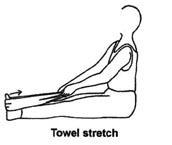
Sit on a hard surface with your injured leg stretched out in front of you. Loop a towel around the ball of your foot and pull the towel toward your body, keeping your knee straight. Hold this position for 30 seconds and repeat 3 times.
Standing calf stretch
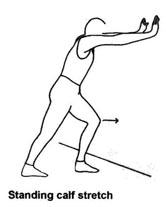
Facing a wall, put your hands against the wall at about eye level. Keep the injured leg back, the uninjured leg forward, and the heel of your injured leg on the floor. Turn your injured foot slightly inward (as if you were pigeon-toed) as you slowly lean into the wall until you feel a stretch in the back of your calf. Hold for 30 seconds. Do this several times a day.
Standing soles stretch
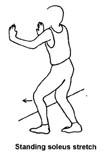
Stand facing a wall with your hands at about chest level. With both knees slightly bent and the injured foot back, gently lean into the wall until you feel a stretch in your lower calf. Once again, slightly toe in with the injured foot and keep your heel down on the floor. Hold this for 30 seconds. Return to the starting position. Repeat 3 times.
Plantar fascia stretch
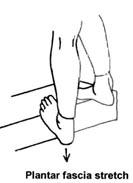
Standing with the ball of your injured foot on a stair and slightly toed out, reach for the bottom of the step with your heel until you feel a stretch in the arch of your foot. Hold this position for 30 seconds. Relax and then repeat 3 times.
Toe raises
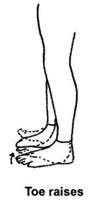
Stand in a normal weight-bearing position. Rock back on your heels so that your toes come off the ground. Hold this position for 5 seconds. Repeat 10 times. Do 3 sets of 10.
Heel raises
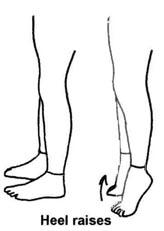
Standing, balance yourself on both feet behind a chair. Rise up on your toes, hold for 5 seconds and then lower yourself down. Repeat 10 times. Do 3 sets of 10.
Single leg balance
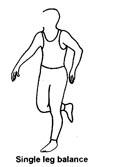
Stand without any support and attempt to balance on your injured leg. Begin with your eyes open and then try to perform the exercise with your eyes closed. Hold the single-leg position for 30 seconds. Repeat 3 times.
Achilles Tendon Exercises
As soon as you can tolerate pressure on the ball of your foot, begin stretching your ankle using the towel stretch. When this stretch is too easy, try the standing calf stretch and soles stretch. You can do exercises 4 and 5 when your ankle swelling has stopped increasing. You may do exercises 6 through 10 when you can stand on your injured ankle without pain.
Towel stretch
Sit on a hard surface with your injured leg stretched out in front of you. Loop a towel around the ball of your foot and pull the towel toward your body, keeping your knee straight. Hold this position for 30 seconds. Repeat 3 times.
Standing calf stretch
Facing a wall, put your hands against the wall at about eye level. Keep the injured leg back, the uninjured leg forward, and the heel of your injured leg on the floor. Turn your injured foot slightly inward (as if you were pigeon-toed). Slowly lean into the wall until you feel a stretch in the back of your calf. Hold for 30 seconds. Do this several times a day.
Standing soles stretch
Stand facing a wall with your hands at about chest level. With both knees slightly bent and the injured foot back, gently lean into the wall until you feel a stretch in your lower calf. Once again, angle the toes of your injured foot slightly inward and keep your heel down on the floor. Hold this for 30 seconds. Return to the starting position. Repeat 3 times.
Ankle range of motion
You can do this exercise sitting or lying down. Pretend you are writing each of the letters of the alphabet with your foot. This will move your ankle in all directions. Do this twice.
Thera-Band exercises
A. Resisted dorsiflexion:
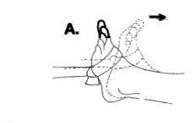
Sitting with your leg out straight and your foot near a door, wrap the tubing around the ball of your foot. Anchor the other end of the tubing to the door by tying a knot in the tubing, slipping it between the door and the frame, and closing the door. Pull your toes toward your face. Return slowly to the starting position. Repeat 10 times. Do 3 sets of 10.
B. Resisted plantar flexion:
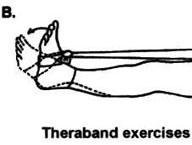
Sitting with your leg outstretched, loop the middle section of the tubing around the ball of your foot. Hold the ends of the tubing in both hands. Gently press the ball of your foot down and point your toes, stretching the Thera-Band. Return to the starting position. Repeat 10 times. Do 3 sets of 10.
C. Resisted inversion:

Sit with your legs out straight and cross your un- injured leg over your injured ankle. Wrap the tubing around the ball of your injured foot and then loop it around your uninjured foot so that the Thera-Band is anchored at one end. Hold the other end of the Thera-Band in your hand. Turn your injured foot inward and up- ward. This will stretch the tubing. Return to the starting position. Repeat 10 times. Do 3 sets of 10.
D. Resisted eversion:

Sitting with both legs out stretched and the tubing looped around both feet, slowly turn your figured foot upward and outward. Hold this position for 5 seconds. Repeat 10 times. Do 3 sets of 10.
Heel raises
Standing, balance yourself on both feet behind a chair. Rise up on your toes, hold for 5 seconds and then lower yourself down. Repeat 10 times. Do 3 sets of 10.
Toe raises
Stand in a normal weight-bearing position. Rock back on your heels so that your toes come off the ground. Hold this position for 5 seconds. Repeat 10 times. Do 3 sets of 10.
Single leg balance
Stand without any support and attempt to balance on your injured leg. Begin with your eyes open and then try to perform the exercise with your eyes closed. Hold the single-leg position for 30 seconds. Repeat 3 times.
Skipping rope
Jump rope landing on both legs for 5 minutes, then on only the injured leg for 5 minutes.
Wobble board
This exercise is important to restore balance and coordination to your ankle. Your physiotherapist can instruct you on their use and will use them in your rehabilitation. Make a wobble board by cutting a circle of plywood two feet across. Place it on top of a 5 or 10-pound weigh, from a barbell set. Stand on the wobble board. Balance first on both legs, then on the injured leg. Do this for 2 to 5 minutes 3 times a day. You may need to hold onto a chair or table for balance.
Special Foot Exercises
You may begin exercising the muscles of your foot right away by gently stretching them as follows:
Towel stretch

Sit on a hard surface with your injured leg stretched out in front of you. Loop a towel around the ball of your foot and pull the towel toward your body, stretching the back of your calf muscle. Hold this position for 30 seconds. Repeat 3 times. When the towel stretch becomes too easy, you may begin doing the standing calf stretch.
Standing calf stretch

Facing a wall, put your hands against the wall at about eye level. Keep the injured leg back, the uninjured leg forward, and the heel of your injured leg on the floor. Turn your injured foot slightly inward (as if you were pigeon-toed) as you slowly lean into the wall until you feel a stretch in the back of your calf. Hold for 30 to 60 seconds. Repeat 3 times. When you can stand comfortably on your injured foot, you can begin stretching the planter fascia at the bottom of your foot.
Plantar fascia stretch

Stand with the ball of your injured foot on a stair. Reach for the bottom step with your heel until you feel a stretch in the arch of your foot. Hold this position for 30 to 60 seconds and then relax Repeat 3 times.
After you have stretched the bottom muscles of your foot, you can begin strengthening the top muscles of your foot.
Frozen can roll
Roll your bare injured foot back and forth from your heel to your mid-arch over a frozen juice can. Repeat for 3 to 5 minutes. This exercise is particularly helpful if done first thing in the morning.
Sitting toe raise
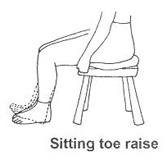
Sit in a chair with your feet flat on the floor. Raise the toes and the ball of your injured foot off the floor while keeping your heel on the floor. Hold for 5 seconds. Repeat 10 times. Do three sets of 10.
Towel pickup
With your heel on the ground, pick up a towel with your toes. Release. Repeat 10 to 20 times.
Next, you can begin strengthening the muscles of your foot and lower leg by using a Thera-Band.
Resisted Thera-Band exercises for the lower leg
A. Resisted dorsiflexion:

Sit with your injured leg out straight and your foot facing a doorway. Tie a loop in one end of the Thera-Band. Put your foot through the loop so that the tubing goes around the arch of your foot. lie a knot in the other end of the Thera-Band and shut the knot in the door. Move backward until there is tension in the tubing. Keeping your knee straight, pull your foot toward your face, stretching the tubing. Slowly return to the starting position. Repeat 10 times. Do 3 sets of 10.
B. Resisted plantar flexion:

Sit with your leg outstretched and loop the middle section of the tubing around the ball of your foot. Hold the ends of the tubing in both hands. Gently press the ball of your foot down and point your toes, stretching the Thera-Band. Return to the starting position. Repeat 10 times. Do 3 sets of 10.
C. Resisted inversion:

Sit with your legs out straight and cross your un- injured leg over your injured ankle. Wrap the tubing around the ball of your injured foot and then loop it around your uninjured foot so that the Thera-Band is anchored there at one end. Hold the other end of the Thera-Band in your hand. Turn your injured foot inward and upward. This will stretch the tubing. Return to the starting position. Repeat 10 times. Do 3 sets of 10.
D. Resisted eversion:
Sit with both legs stretched out in front of you, with your feet about a shoulder's width apart. Tie a loop in one end of the Thera-Band. Put your injured foot through the loop so that the tubing goes around the arch of that foot and wraps around the outside of the uninjured foot. Hold onto the other end of the tubing with your hand to provide tension. Turn your injured foot up and out. Make sure you keep your uninjured foot still so that it will allow the tubing to stretch as you move your injured foot. Return to the starting position. Repeat 10 times. Do 3 sets of 10.
Post Op Physiotherapy Protocols
You will need the Adobe Reader to view and print these documents. 
